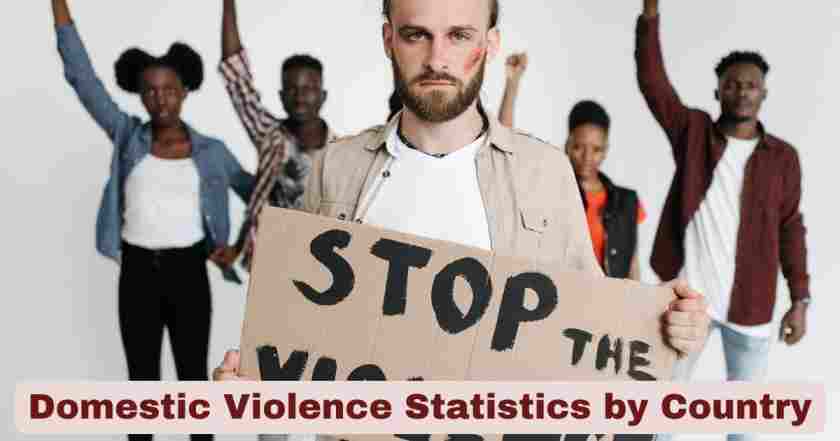Domestic Violence by Country 2025
The landscape of domestic violence statistics by country 2025 continues to reveal one of the most pressing human rights crises of our time, affecting millions of women and girls across every continent. Recent comprehensive data from the World Health Organization and UN Women demonstrates that 736 million women globally have experienced physical and/or sexual violence by intimate partners or other perpetrators at least once in their lifetime. This staggering figure represents 30% of all women aged 15 and older worldwide, underscoring the universal nature of this epidemic that transcends borders, cultures, and economic systems.
The 2025 domestic violence statistics paint a sobering picture of systematic violence that occurs predominantly in the private sphere, with 60% of all female homicides committed by intimate partners or family members compared to just 12% of male homicides. What makes these statistics particularly alarming is that they represent only reported cases and documented incidents, with experts estimating that the actual prevalence could be significantly higher due to underreporting, social stigma, and limited access to support services. The data reveals that every 10 minutes, a woman is killed by someone in her own family, translating to approximately 140 women and girls killed daily by intimate partners or family members worldwide.
Key Stats & Facts About Domestic Violence by Country 2025
| Global Statistic | Data | Source |
|---|---|---|
| Total women affected globally | 736 million women (30% of women 15+) | WHO Violence Against Women Report 2024 |
| Women killed daily by family/partners | 140 women per day (51,100 annually) | UN Women Global Database 2024 |
| Intimate partner violence prevalence | 640 million women (26% globally) | WHO Prevalence Estimates 2024 |
| Female homicides by intimates | 60% of all female murders | UN Women Femicide Report 2024 |
| Frequency of intimate partner killing | Every 10 minutes a woman is killed | UN Women 2024 |
| Women seeking help | Less than 40% seek any form of help | UN Statistics Division 2024 |
| Police reporting rate | Less than 10% report to police | UN Statistics Division 2024 |
| Countries with IPV data | 161 countries have prevalence data | UN Women Database 2024 |
| Adolescent girls affected | 24% by age 19 experience partner violence | WHO Adolescent Violence Report 2024 |
| Non-partner sexual violence | 6% of women globally affected | WHO Global Estimates 2024 |
| Technology-facilitated violence | 73% of women journalists experience online violence | UNESCO Global Survey 2024 |
| Economic cost in European Union | €366 billion annually | European Institute for Gender Equality 2024 |
Data Sources: WHO Violence Against Women Prevalence Estimates 2024, UN Women Facts and Figures 2024, UNESCO Technology-Facilitated Violence Reports 2024
These domestic violence statistics by country 2025 represent the most comprehensive global data collection effort to date, with information now available from 161 countries compared to limited data availability in previous decades. The statistics demonstrate that 736 million women—almost one in three—have been subjected to physical and/or sexual intimate partner violence, non-partner sexual violence, or both at least once in their life. This figure excludes sexual harassment, suggesting that the true scope of gender-based violence is even more extensive than these already staggering numbers indicate.
The data reveals critical patterns in help-seeking behavior, with less than 40 per cent of the women who experience violence seek help of any sort, and among those who do seek assistance, less than 10 per cent of those seeking help appealed to the police. This significant gap between victimization and formal reporting highlights the hidden nature of domestic violence and the barriers survivors face in accessing justice and support services. The preference for seeking help from family and friends rather than formal institutions underscores the need for comprehensive community-based responses and improved accessibility of professional services.
Regional Analysis of Domestic Violence Statistics 2025
WHO Regional Domestic Violence Statistics 2025
| WHO Region | Lifetime IPV Prevalence Rate | Estimated Women Affected (Millions) | Regional Ranking |
|---|---|---|---|
| WHO African Region | 33% | 89.2 million | Highest |
| WHO South-East Asia Region | 33% | 168.5 million | Highest |
| WHO Eastern Mediterranean | 31% | 45.8 million | High |
| WHO Americas Region | 25% | 78.4 million | Moderate |
| WHO European Region | 22% | 82.1 million | Lower |
| WHO Western Pacific | 20% | 156.3 million | Lowest |
Data Sources: WHO Violence Against Women Prevalence Estimates 2024, WHO Regional Offices Statistical Reports 2024
The WHO regional domestic violence statistics 2025 reveal significant geographical variations in intimate partner violence prevalence, with the WHO African region and WHO South-East Asia region both showing 33% lifetime intimate partner violence rates. These regions face unique challenges including armed conflicts, economic instability, weak legal frameworks, and cultural practices that may normalize violence against women. The WHO African region’s 33% rate affects an estimated 89.2 million women, while the South-East Asia region’s identical rate impacts a staggering 168.5 million women due to the region’s larger population.
The WHO Eastern Mediterranean Region shows a 31% prevalence rate, affecting approximately 45.8 million women across countries facing ongoing conflicts and social upheaval. In contrast, the WHO Western Pacific region demonstrates the lowest rate at 20%, though this still represents 156.3 million affected women due to the region’s massive population. European high-income countries show a 22% prevalence rate, indicating that even nations with advanced social protection systems and gender equality legislation continue to struggle with intimate partner violence. The data demonstrates that domestic violence by country 2025 remains a universal challenge requiring sustained, evidence-based interventions regardless of economic development level.
Intimate Partner Violence Fatality Statistics 2025
| Statistic Category | Global Data | Regional Variations | Comparative Analysis |
|---|---|---|---|
| Total annual femicides | 51,100 women killed | Varies by region | 140 deaths daily |
| Intimate partner femicides | 60% of all female homicides | Africa: Highest rates | vs 12% male homicides |
| Family-related female deaths | Every 10 minutes | Americas: High rates | 10x higher than males |
| Domestic violence escalation | 38% of female murders | Asia-Pacific: Moderate | Most preventable deaths |
Data Sources: UN Women Global Study on Homicide 2024, UNODC Global Study on Homicide 2024
The domestic violence fatality statistics 2025 present the most tragic outcome of intimate partner violence, with around 51,100 women and girls worldwide killed by their intimate partners or other family members in 2023. This translates to 140 women or girls killed every day by someone in their own family, representing the ultimate expression of gender-based violence. The gender disparity in intimate partner homicides is stark, with 60 per cent of all female homicides committed by intimate partners or other family members, while only 12 per cent of all male homicides are perpetrated in the private sphere.
These 2025 domestic violence statistics highlight the preventable nature of intimate partner femicides, as many cases involve escalating patterns of abuse that could have been interrupted with appropriate interventions. Globally, as many as 38% of all murders of women are committed by intimate partners, indicating that the majority of female homicides occur within supposedly safe domestic spaces. The data underscores the critical importance of risk assessment tools, emergency protection measures, and coordinated community responses to identify and protect women at highest risk of lethal violence.
Technology-Facilitated Domestic Violence Statistics 2025
| Platform/Method | Prevalence Rate | Most Affected Groups | Regional Variations |
|---|---|---|---|
| Online harassment | 73% of women journalists | Women in public life | Global phenomenon |
| Cyber-harassment (EU) | 10% of women | Women 15+ years | European Union |
| Social media abuse | 44% of women MPs | Female parliamentarians | Five regions studied |
| Technology violence (Arab States) | 60% of women users | Internet users | Arab region |
| Online violence (Eastern Europe) | 50%+ of women | Online women | Western Balkans/Eastern Europe |
| Digital harassment (Uganda) | 49% of women | Online participants | Sub-Saharan Africa |
Data Sources: UNESCO Global Survey on Violence Against Women Journalists 2024, UN Women Technology-Facilitated Violence Reports 2024, Regional Digital Violence Studies 2024
Technology-facilitated domestic violence has emerged as a critical component of domestic violence statistics by country 2025, with 73 per cent of women journalists experiencing online violence according to UNESCO’s global survey. This form of violence extends beyond traditional boundaries, enabling perpetrators to harass, stalk, and threaten victims across multiple digital platforms. In the Arab States, 60 per cent of women internet users had been exposed to online violence in the past year, while in the Western Balkans and Eastern Europe, more than half of women present online have experienced some form of technology-facilitated violence.
The intersection of domestic violence and digital technology creates new avenues for control and abuse, with 44 per cent of women lawmakers reporting receiving death, rape, assault, or abduction threats towards them or their families through social media platforms. In Uganda, 49 per cent of women reported being involved in online harassment, demonstrating that technology-facilitated violence affects women across different economic and social contexts. The global nature of digital platforms means that technology-facilitated domestic violence can transcend national boundaries, requiring international cooperation and coordinated responses to address this growing form of gender-based violence effectively.
Vulnerable Populations and Domestic Violence Statistics 2025
| Vulnerable Group | Increased Risk Factor | Specific Challenges | Support Access Rate |
|---|---|---|---|
| Women with disabilities | Higher risk of all forms of IPV | Physical/communication barriers | Limited accessible services |
| Adolescent girls | 24% experience partner violence by age 19 | Limited autonomy/resources | 1% seek professional help |
| Climate-displaced women | 80% of climate displaced are women | Loss of support systems | Emergency services only |
| Women in humanitarian contexts | 70% experience GBV | Breakdown of protection systems | 35% vs global average |
| Women in conflict areas | 4% higher child marriage rates | Legal system breakdown | Severely limited |
| Trafficked women | 91% of sex trafficking victims female | Complete isolation | Rescue-dependent |
Data Sources: WHO Disability and Violence Studies 2024, UNICEF Adolescent Violence Data 2024, UNHCR Displacement and Gender Statistics 2024
Vulnerable populations face disproportionately high rates of domestic violence, with specific groups experiencing multiple intersecting forms of discrimination and violence. Almost 1 in 4 adolescent girls (24 per cent) who have been in a relationship have already been physically, sexually, or psychologically abused by a partner by age 19, yet only one per cent have ever sought professional help. This alarming gap between victimization and help-seeking among young women highlights the particular vulnerabilities faced by adolescents who may lack the resources, autonomy, or awareness to access support services.
Women with disabilities report a higher rate of all forms of intimate partner violence than women without disabilities, facing additional barriers including physical inaccessibility of services, communication challenges, and societal assumptions about their relationships and sexuality. Climate change has emerged as a significant factor, with 80 per cent of people displaced by climate change being women, creating new vulnerabilities to violence. In humanitarian contexts, 70 per cent of women experience gender-based violence compared with 35 per cent worldwide, demonstrating how crisis situations exponentially increase women’s risk of experiencing violence while simultaneously reducing their access to protection and support services.
Legal Frameworks and Government Response Statistics 2025
| Legal Protection Measure | Global Coverage | Implementation Rate | Effectiveness Indicators |
|---|---|---|---|
| Countries with domestic violence laws | 165 countries | 104 comprehensive laws | 9.5% vs 16.1% IPV rates |
| Sexual harassment employment laws | 151 countries | Varies significantly | Limited impact data |
| Sexual harassment public space laws | 39 countries | Low implementation | Emerging effectiveness |
| Robust legal protection coverage | 14% of women globally | 557 million women protected | Strong correlation with safety |
| Rape laws based on consent | 40% of countries | 60% lack consent-based laws | Higher conviction rates |
| Cyber harassment laws | Less than 50% | Limited coverage | Emerging field |
Data Sources: UN Women Global Database on VAWG 2024, World Bank Women, Business and Law Report 2024, Inter-Parliamentary Union Legal Database 2024
Legal frameworks addressing domestic violence have expanded significantly, with 165 countries having domestic violence laws, though only 104 countries have comprehensive legislation addressing domestic violence. The impact of legislation is demonstrable, as countries with domestic violence legislation have lower rates of intimate partner violence than those without such legislation (9.5 per cent compared to 16.1 per cent). However, the existence of laws does not automatically translate to protection, with only 14 per cent of all women and girls—about 557 million—living in countries with robust legal protection that guarantees fundamental human rights.
Significant gaps remain in legal protection, particularly in emerging areas of violence. Over 60 per cent of countries still lack rape laws based on the principle of consent, while less than half of the global population of women are protected by laws against cyber harassment. 151 countries have laws on sexual harassment in employment, but only 39 have laws prohibiting sexual harassment in public spaces, highlighting the uneven development of legal protections across different spheres of women’s lives. The 2025 domestic violence statistics demonstrate that while legislative progress continues, implementation and enforcement remain critical challenges requiring sustained political commitment and adequate resource allocation.
Economic Impact of Domestic Violence Statistics 2025
| Country/Region | Annual Economic Cost | GDP Percentage | Key Cost Components |
|---|---|---|---|
| European Union | €366 billion | Significant portion | 79% from violence against women |
| Vietnam | 1.41% of GDP | Major economic drain | 35% earnings reduction for survivors |
| Egypt | USD 14+ million health costs | 500,000 lost work days | Serves only 25% of survivors |
| Morocco | USD 308 million | 2.85 billion dirhams | Physical and sexual violence costs |
Data Sources: European Institute for Gender Equality 2024, UN Women Economic Impact Studies 2024, National Cost-Benefit Analyses 2024
The economic impact of domestic violence represents a massive drain on global resources, with the cost of gender-based violence in the European Union estimated at EUR 366 billion a year, with violence against women making up 79 per cent of this cost, or EUR 289 billion. These costs encompass direct expenses such as healthcare, legal proceedings, and social services, as well as indirect costs including lost productivity, reduced economic participation, and long-term health consequences. In Viet Nam, the combined costs of out of pocket expenditures and lost earnings due to violence represent nearly 1.41 per cent of the GDP, with women experiencing violence earning 35 per cent less than those who have not.
Country-specific data reveals the substantial economic burden across different regions and income levels. In Egypt, an estimated 500,000 working days are lost each year due to marital violence and the health sector bears over USD 14 million in costs to serve just one quarter (600,000) of survivors. In Morocco, the total annual cost of physical and/or sexual violence against women was estimated at 2.85 billion dirhams (around USD 308 millions) a year. These domestic violence statistics by country 2025 demonstrate that investing in prevention and response programs not only saves lives but also generates significant economic returns through reduced healthcare costs, increased productivity, and enhanced economic participation of women.
Climate Change and Humanitarian Crises Impact on Domestic Violence 2025
| Crisis Type | Violence Increase | Affected Population | Specific Impacts |
|---|---|---|---|
| Climate displacement | 80% of displaced are women | Millions annually | Loss of protection systems |
| Natural disasters | Significant spikes in GBV | Disaster-affected areas | 6x rape increase post-Katrina |
| Conflict situations | 4% higher child marriage | Conflict-affected areas | Breakdown of legal systems |
| Economic crises | Increased IPV rates | Economically vulnerable | Stress and resource scarcity |
| Humanitarian emergencies | 70% vs 35% global rate | Displaced populations | Service disruption |
| Environmental degradation | Increased trafficking | Rural populations | Economic desperation |
Data Sources: UNHCR Global Trends 2024, UNFPA Humanitarian Response Reports 2024, Climate Change and Violence Research 2024
Climate change and humanitarian crises significantly amplify domestic violence risk, with 80 per cent of people displaced by climate change being women, creating heightened vulnerabilities to gender-based violence. Natural disasters create conditions that facilitate violence through social disruption, economic stress, and breakdown of protection systems. After Hurricane Katrina in 2005, the rate of rape among displaced women rose 6 times the baseline rate in Mississippi, while following the Canterbury earthquake, New Zealand police reported a 53 per cent rise in domestic violence.
Child marriage rates are 4 percentage points higher in conflict-affected areas, demonstrating how crisis situations increase harmful practices against girls and women. Economic desperation resulting from environmental degradation drives trafficking and other forms of exploitation, with Nepal witnessing an increase in trafficking from an estimated 3,000-5,000 annually in 1990 to 12,000-20,000 per year after the 2015 earthquake. In Ethiopia, there was an increase in girls sold into early marriage in exchange for livestock to help families cope with prolonged droughts. These 2025 domestic violence statistics highlight the critical need for gender-sensitive disaster preparedness and response strategies that address the heightened risks women face during and after humanitarian crises.
Prevention and Intervention Effectiveness Statistics 2025
| Intervention Type | Evidence Base | Effectiveness Rate | Implementation Challenges |
|---|---|---|---|
| Economic empowerment programs | Strong evidence | Significant impact | Resource intensive |
| Community mobilization | Growing evidence | Norm change focus | Long-term commitment needed |
| Legal system reforms | Moderate evidence | Variable results | Implementation gaps |
| Health sector response | Established protocols | Survivor support | Training requirements |
| Educational interventions | School-based programs | Prevention focus | Curriculum integration |
| Technology solutions | Emerging evidence | Safety planning | Digital divide |
Data Sources: WHO RESPECT Framework Implementation Reports 2024, Cochrane Reviews of Violence Prevention 2024, Prevention Research Synthesis 2024
Evidence-based prevention programs demonstrate measurable effectiveness in reducing domestic violence rates when implemented with fidelity and adequate resources. Economic empowerment programs consistently show strong results by addressing one of the key factors that keep women in abusive relationships – financial dependency. Community mobilization interventions that engage local leaders, religious institutions, and community members in challenging social norms that condone violence have shown promising results in changing attitudes and behaviors at the population level.
School-based prevention programs that promote healthy relationship skills and challenge gender stereotypes from an early age represent a critical investment in primary prevention. These programs reach young people before harmful relationship patterns become established and have shown effectiveness in reducing dating violence among adolescents. Technology-based interventions, including safety planning apps, GPS monitoring systems, and online support services, offer innovative solutions for enhancing survivor safety and expanding access to services, particularly for women in rural or isolated areas where traditional services may be limited.
Future Outlook
The trajectory of domestic violence statistics by country 2025 suggests both encouraging progress and persistent challenges that will require sustained global commitment and innovative approaches. Technological advances continue to offer new tools for prevention, early intervention, and survivor support, with artificial intelligence-powered risk assessment systems showing promise for identifying high-risk situations before they escalate to fatal violence. The expansion of telehealth and virtual support services has improved accessibility for survivors in remote areas, while blockchain technology offers potential solutions for secure data sharing among service providers while protecting survivor privacy and safety.
International cooperation frameworks are strengthening, with regional bodies increasingly adopting comprehensive approaches to violence against women based on successful models like the Council of Europe’s Istanbul Convention. The integration of violence against women indicators into national statistical systems is improving, with 161 countries now providing prevalence data compared to limited data availability a decade ago. However, significant data gaps remain, particularly regarding technology-facilitated violence, violence against marginalized populations, and the long-term impacts of violence on survivors and their children.
Climate change adaptation strategies must increasingly incorporate gender-based violence prevention and response measures, as environmental crises continue to displace populations and disrupt social protection systems. The recognition that 80% of climate-displaced persons are women is driving more gender-sensitive humanitarian response protocols, while early warning systems are beginning to include gender-based violence risk indicators. Economic recovery programs following the global pandemic have highlighted the importance of women’s economic empowerment in both preventing violence and supporting survivor independence, with evidence showing that women experiencing violence earn 35% less than those who haven’t experienced violence, creating a compelling case for integrated economic and violence prevention programming that addresses these interconnected challenges simultaneously.
Disclaimer: The data research report we present here is based on information found from various sources. We are not liable for any financial loss, errors, or damages of any kind that may result from the use of the information herein. We acknowledge that though we try to report accurately, we cannot verify the absolute facts of everything that has been represented.







